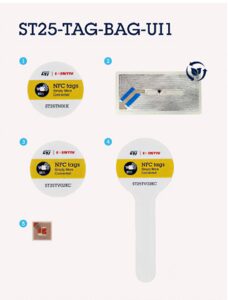What if making a product or a business more environmentally friendly didn’t start with lofty promises, crazy goals, and unrealistic expectations but a tiny step? What if, in fact, meaningful change began with something as small as an NFC tag? This is the premise behind our white paper entitled “NFC for sustainability”. Sustainability is on everyone’s mind, but it’s hard to figure out how to go beyond simple lip service. That’s why the white paper offers practical guidelines applicable to numerous industries, from consumer electronics to healthcare or industrial applications.
Industries are already gauging how NFC can improve their environmental impact. A tag is thin and small, which enables it to fit onto many products, and it primarily uses a small chip, a substrate, and an antenna. ST’s tags ICs all use conflict-free minerals, while their programmability makes them highly flexible and reusable. Hence, companies use tags to track and trace as well as inform, warn, or incentivize customers. Put simply, tags are a way to create new and more sustainable ecosystems. Let’s, therefore, explore the solutions available today that can help teams go beyond the white paper.
NFC: How to think about the technology in a practical way
ST25Connect
To make NFC more practical, ST launched ST25Connect, an initiative that guides engineers and decision-makers by offering case studies, experience-driven documentation, and support. For example, ST25Connect shows how NFC can help consumers configure their products or track assets worldwide. In the first instance, using an NFC tag in a mass-market application can help reduce support costs, eliminate paper documents, and improve the overall experience. Similarly, asset tracking is a great tool to minimize losses and significantly reduce wasteful operations. NFC tags thus enable such applications for those that cannot implement a sub-GHz network or extensive infrastructure.
ST25Connect also aims to provide application-based resources. One example is the content around the use of NFC by luxury brands. The white paper details the use of an NFC tag by Paco Rabanne that taught customers about refillable bottles to reduce waste. ST25Connect also brings more context and expertise to help engineers get started. In a short time, teams thus obtain a much stronger grasp of the subject matter to determine how to improve their operations, reduce their carbon footprint, and make sustainability a reality rather than a marketing story.
ST Tag Bags

Developers can also start experimenting with NFC by grabbing one of our Tag Bags, a bundle containing various tags easily configurable using a smartphone app. There’s no coding required or even expertise in Near-Field Communication needed. After reading the white paper and learning more about ST25Connect, users can grab the ST25-TAG-BAG-UI1, for instance, and write data to the tags in minutes. We even offer a webinar on capturing inertial and ambient data with ST’s new NFC-enabled sensor node, to help companies gather more data, which can potentially lead to optimizations. Hence, our objective is to make NFC more accessible, so teams quickly go from an idea to a practical proof-of-concept with sustainability ramifications.
NFC for sustainability: How to create practical applications
Answering the why before the how
One of the reasons that drive us to lower the barrier to entry to NFC is that figuring out how to use technology to improve a company’s environmental impact is a tremendous challenge. Indeed, in many instances, NFC brings digitization to products and industries that had none. Consequently, the biggest hurdle when putting NFC onto a wine or perfume bottle isn’t necessarily how to install the tag but what type of applications to create. That’s why the white paper provides ideas and case studies that teams can draw from. ST25Connect then goes a step further by becoming a bridge between ST and our customers with a contact form at the bottom of the page.
Sustainability improvements in the clothing industry
Some markets are already looking at NFC to improve sustainability, and there’s increasing research on the matter. For instance, the world of fashion and luxury is looking to use NFC to replace labels1. The industry is struggling with its environmental impact as it wrestles with waste and resource management, and some are looking into contactless solutions. Using an NFC tag instead of a physical label would cut down on paper and enable brands to reuse in-store tags or update them instead of printing new stickers. Moreover, Vishaka Agarwal from the National Institute of Fashion Technology in New Delhi and the Indian Ministry of Textiles published a paper2 detailing how NFC could “change the face of retail.”
Sustainability improvements in food chains
Similarly, research is also exploring the use of NFC when it comes to tracking. For instance, according to a paper from Italy3, food chains could greatly benefit from NFC tags. When dealing with commodities, using a sub-GHz network to monitor assets is simply too cost-prohibitive. On the other hand, NFC provides digitization at a fraction of the cost. Placing tags on crates or animals opens the door to traceability and efficiency with little investment. For instance, another paper on NFC in olive oil supply chains4 shows significant improvements in operations, which could lead to lower emissions, among other things, for a technology that represents only 1% of the total cost.
Practical considerations
The white paper, and ST’s strategy in general, is to use NFC meaningfully. The point isn’t to put a tag on every wine bottle, track every piece of vegetable, or digitize every single industry. However, the white paper, ST25Connect, and all our other initiatives testify to the simple fact that sustainability must be everyone’s concern. From engineers to application developers and from decision-makers to end users, all must adopt new habits, optimize resource management, and be more intentional with our consumption. NFC is already helping do that. The white paper is here to ensure ST customers jump on the bandwagon.
- Learn more about how NFC can improve sustainability by downloading the white paper
- Get started with ST25Connect
- Park, Michelle. Labeling Is Out Of Fashion: NFC Technology Towards Sustainability In Fashion Retail. 2018. Kent State University. OhioLINK Electronic Theses and Dissertations Center, http://rave.ohiolink.edu/etdc/view?accnum=ksuhonors1525695778821744. ↩
- Agarwal, V. (2019). Technology, Sustainability, and Consumer Expectation—New Ways of Thinking About Future Fashion. In: Chakrabarti, A. (eds) Research into Design for a Connected World. Smart Innovation, Systems and Technologies, vol 134. Springer, Singapore. https://doi.org/10.1007/978-981-13-5974-335 ↩
- Pigini D, Conti M. NFC-Based Traceability in the Food Chain. Sustainability. 2017; 9(10):1910. https://doi.org/10.3390/su9101910 ↩
- Pigini D, Conti M. NFC-Based Traceability in the Food Chain. Sustainability. 2017; 9(10):1910. https://doi.org/10.3390/su9101910 ↩
